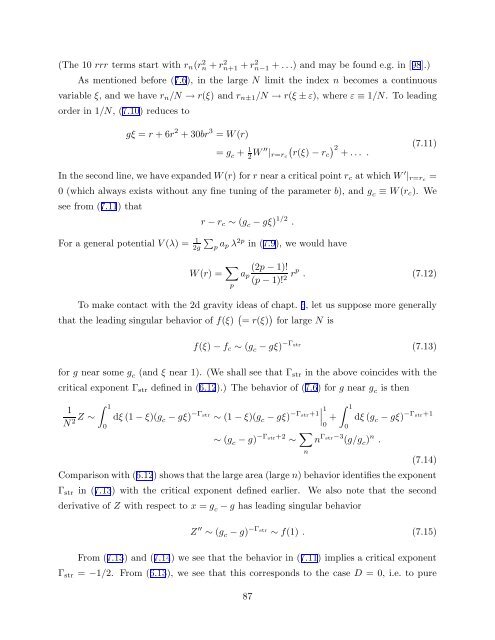arXiv:hep-th/9304011 v1 Apr 5 1993
arXiv:hep-th/9304011 v1 Apr 5 1993
arXiv:hep-th/9304011 v1 Apr 5 1993
You also want an ePaper? Increase the reach of your titles
YUMPU automatically turns print PDFs into web optimized ePapers that Google loves.
(The 10 rrr terms start wi<strong>th</strong> r n (r 2 n + r 2 n+1 + r 2 n−1 + . . .) and may be found e.g. in [98].)<br />
As mentioned before (7.6), in <strong>th</strong>e large N limit <strong>th</strong>e index n becomes a continuous<br />
variable ξ, and we have r n /N → r(ξ) and r n±1 /N → r(ξ ± ε), where ε ≡ 1/N. To leading<br />
order in 1/N, (7.10) reduces to<br />
gξ = r + 6r 2 + 30br 3 = W (r)<br />
= g c + 1 2 W ′′ | r=rc<br />
(<br />
r(ξ) − rc<br />
) 2<br />
+ . . . .<br />
(7.11)<br />
In <strong>th</strong>e second line, we have expanded W (r) for r near a critical point r c at which W ′ | r=rc =<br />
0 (which always exists wi<strong>th</strong>out any fine tuning of <strong>th</strong>e parameter b), and g c ≡ W (r c ). We<br />
see from (7.11) <strong>th</strong>at<br />
r − r c ∼ (g c − gξ) 1/2 .<br />
For a general potential V (λ) = 1 ∑<br />
2g p a p λ 2p in (7.9), we would have<br />
W (r) = ∑ p<br />
a p<br />
(2p − 1)!<br />
(p − 1)! 2 rp . (7.12)<br />
To make contact wi<strong>th</strong> <strong>th</strong>e 2d gravity ideas of chapt. 6, let us suppose more generally<br />
<strong>th</strong>at <strong>th</strong>e leading singular behavior of f(ξ) ( = r(ξ) ) for large N is<br />
f(ξ) − f c ∼ (g c − gξ) −Γ str<br />
(7.13)<br />
for g near some g c (and ξ near 1). (We shall see <strong>th</strong>at Γ str in <strong>th</strong>e above coincides wi<strong>th</strong> <strong>th</strong>e<br />
critical exponent Γ str defined in (6.12).) The behavior of (7.6) for g near g c is <strong>th</strong>en<br />
∫<br />
1<br />
1<br />
N 2 Z ∼<br />
0<br />
dξ (1 − ξ)(g c − gξ) −Γ str<br />
∼ (1 − ξ)(g c − gξ) −Γ str+1<br />
∣ 1 +<br />
0<br />
∼ (g c − g) −Γ str+2 ∼ ∑ n<br />
∫ 1<br />
0<br />
n Γ str−3 (g/g c ) n .<br />
dξ (g c − gξ) −Γ str+1<br />
(7.14)<br />
Comparison wi<strong>th</strong> (6.12) shows <strong>th</strong>at <strong>th</strong>e large area (large n) behavior identifies <strong>th</strong>e exponent<br />
Γ str in (7.13) wi<strong>th</strong> <strong>th</strong>e critical exponent defined earlier.<br />
derivative of Z wi<strong>th</strong> respect to x = g c − g has leading singular behavior<br />
We also note <strong>th</strong>at <strong>th</strong>e second<br />
Z ′′ ∼ (g c − g) −Γ str<br />
∼ f(1) . (7.15)<br />
From (7.13) and (7.14) we see <strong>th</strong>at <strong>th</strong>e behavior in (7.11) implies a critical exponent<br />
Γ str = −1/2. From (6.13), we see <strong>th</strong>at <strong>th</strong>is corresponds to <strong>th</strong>e case D = 0, i.e. to pure<br />
87
















